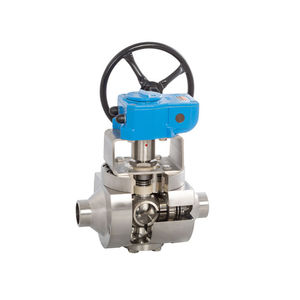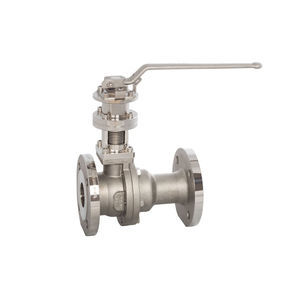
- Hydraulics - Pneumatics
- Valve
- Ball valve
- KLINGER-SCHÖNEBERG GmbH
Ball valve pneumaticfor controlshut-off
Add to favorites
Compare this product
Characteristics
- Type
- ball
- Operation
- pneumatic
- Function
- for control, shut-off
- Applications
- welding
- Other characteristics
- high-temperature, single-acting
- DN
300 mm
(11.811 in)- Pressure
Max.: 160 bar
(2,320.6 psi)Min.: 40 bar
(580.2 psi)
Description
In conventional power plants, such as coal-fired or gas-fired power plants, water is heated in the steam generator by combustion. The resulting steam is used to drive turbines at very high pressure and temperature. A generator is coupled to these turbines, which converts the mechanical power into electrical power.
For this purpose, the KLINGER Schöneberg ball valve with welding ends type INTEC K211-S-HT DN40 PN160 is used. The ball valve has been specially designed for the application of venting and draining superheated steam in conventional power plants with process conditions of 325°C and an operating pressure of 27.5 bar. To protect the automation unit (consisting of single-acting pneumatic actuator and Topworx limit switch box) from excessive temperature, mounting bridge and two stem extensions with total height of approx. 300 mm were built in combination.
The variant used is a trunnion-mounted metal-seated ball valve with both side spring loaded seat rings. Ball and seats are made of Superduplex material (1.4980) and coated with nickel-based hard alloy (SC4) by thermal spraying with subsequent melting to produce a non-porous hard material. This results in the highest resistance of the ball-seat system during thermal cycling.
This ensures a reliable tight seal and maintenance-free operation even in applications with high operating cycles, which is crucial in power plants.
Catalogs
No catalogs are available for this product.
See all of KLINGER-SCHÖNEBERG GmbH‘s catalogsRelated Searches
- Valve
- Hand valve
- Control valve
- Stainless steel valve
- Ball valve
- Pneumatic valve
- Threaded valve
- Regulating valve
- Stop valve
- Lever control valve
- Electric valve
- ISO valve
- Biogas valve
- Valve with handwheel
- Pneumatically-operated valve
- Piston actuator valve
- Valve for the chemical industry
- Nickel-plated brass valve
- Standard valve
- Carbon steel valve
*Prices are pre-tax. They exclude delivery charges and customs duties and do not include additional charges for installation or activation options. Prices are indicative only and may vary by country, with changes to the cost of raw materials and exchange rates.




